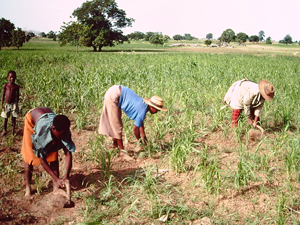 |
|
A man and two of his wives working on a farm belonging to one of the women |
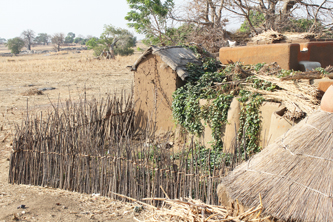 |
|
A dry-season garden |
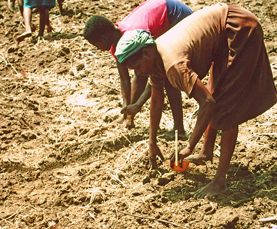 |
|
Sowing millet |
Traditional Activities of Bulsa Women
When traditional activities of African women are discussed, the main focus is on their roles as mothers of many children and on their endeavors in preparing food for their husbands and children.
Although in our present time Bulsa women can be found working as teachers, traders, secretaries, nurses, craftswomen, etc., most women living in traditional compounds still dedicate the majority of their time to the processing of millet. Two main species of this very important cereal are known to the Bulsa: guinea corn or Sorghum vulgare (see box) and the grey Pennisetum millet (see box).
|
Millet species and varieties grown in Bulsaland
A) PENNISETUM Naara, early millet, harvest in July/August Naara yuluk: particularly grown in Chuchuliga Naara muning: variety Kinkana: This is no species or variety, but rather a name for unripe Pennisetum; not very suitable for TZ Za-piela: Pennisetum typhoides, late millet; looks like naara but is harvested at the same time as za-monta (a few days after the harvest of beans)
B) SORGHUM (Guinea corn) Za-monta: Sorghum bicolor; used for making pito (daam) Za-pie-moaning: a variation; grains are lighter than those of Za-monta Gilim-gilim-poning: used as medicine against giddiness Bawku White: innovation; white grains; harvested a short time before za-monta Naga White, Buli posuk-nimbiri or za-geli: innovation; white grains; first harvest (end of August) before Bawku White: after cutting off the heads they grow again; grains are open and vulnerable to being eaten by birds |
Millet
 |
|
A man and two of his wives working on a farm belonging to one of the women |
 |
|
A dry-season garden |
 |
|
Sowing millet |
In the past, most Bulsa women did not possess their own millet fields, but received from their husbands a certain amount of unthreshed millet to be used for a certain period of time (e.g. a few weeks). Recently, many husbands have begun giving a parcel of land to each wife. Here, assisted by either her sons or paid workers, the women can grow millet and other plants for the preparation of millet porridge, also called TZ (an abbreviation of the Hausa term tuo zaafi “hot food”).
Acquiring the ingredients for the soup or sauce accompanying this porridge has always been up to a married wife. To provide these, she and her sons keep a small, dry-season garden near their living quarters, and it produces leafy vegetables, tomatoes and spices in the dry season.
Compared to other African societies, the Bulsa womens’ share of agricultural work is relatively low. Nevertheless, there is one activity that can only be done by a woman: sowing millet. It is a man who makes holes in the tilled field but the woman who places 3-5 seeds into the holes and closes them with her heel. The main idea behind this is the association of women with fertility. In the same way, women give life to others, the planted seeds should bear fruit as well.
For the daily meals, the women pound the unthreshed millet in a mortar to remove the spelt. In some parts of Bulsaland they do no use wooden but rather rock mortars (i.e. they de-husk the millet in small, subrecent rock holes created by their ancestors).
After winnowing the grains by pouring them from one big calabash to another (see photo), they are ground in a grinding room. Next to the beating and kneading required for the production of shea butter, grinding millet is one of a woman’s most exhausting jobs in a traditional household. This work is done in a particular small clay building whose entrance is so narrow that the woman can enter it only in a creeping manner. It has no windows but only 1-2 peepholes through which the woman can, for example, watch her playing toddlers. In hot weather the straw cover of the grinding room can be taken off to allow some kind of ventilation.
In some respects, the grinding woman can be compared to a car-driver who, thanks to the noise of the engine, the speed of his car and reflective windows, is somewhat isolated from the surroundings. This isn’t to say that a driver can’t give messages to the outside world. On the contrary, such a situation can in some cases lead to the driver engaging in somewhat aberrant behavior, like using the horn in an intrusive way or swearing through a half-open window.
The women grinding the millet find themselves in a similar situation. To make their work easier, they sing loudly. The lyrics of their songs, invented ad hoc for that situation, address the strenuous work or are aggressively aimed at the world of men and the unrelated inhabitants in her compound. The songs are perhaps a kind of therapy for the soul through which she can relieve her pent up feelings.
In one of the songs I collected, a young woman is singing:
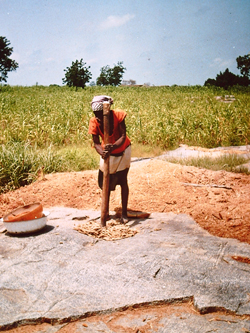 |
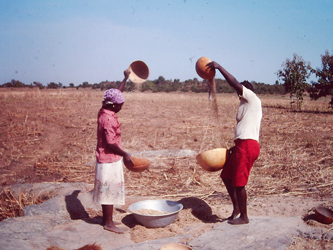 |
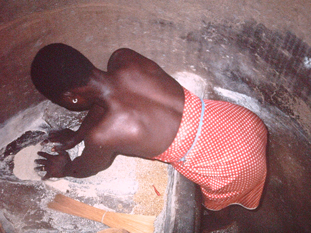 |
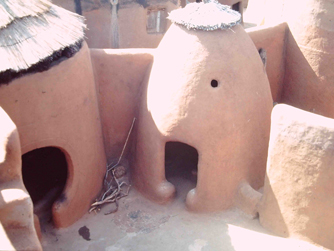 |
|
Pounding millet in a rock mortar |
Winnowing millet grains |
In the grinding room | A grinding-room with a peep-hole |
The mankarik-millet seeds are very hard.
When my time of receiving presents [as a newly married wife] is over,
I will run home to my parents.
In recent times, many women have begun paying a small fee to make use of grinding mills with diesel-powered engines (nika-nika).
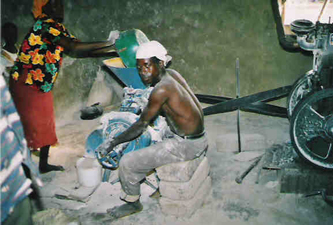 |
|
Grinding-mill (nika-nika) |
The ground millet has many uses but is particularly used for the millet porridge, the staple food of Northern Ghana.
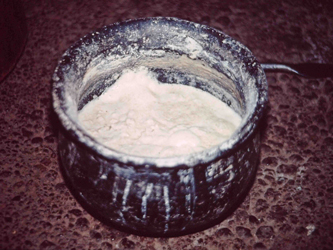 |
|
Fermented "sour water" |
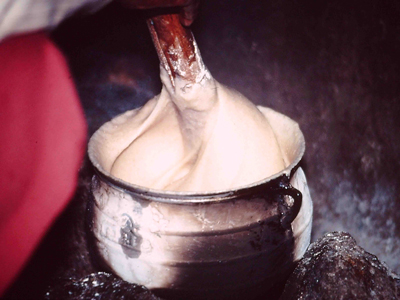 |
| Last phase of stirring the TZ |
|
|
|
The ingredients are pounded in a small mortar |
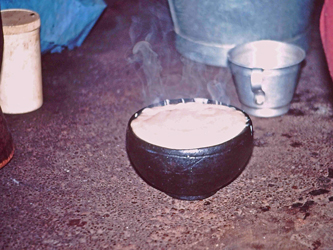 |
|
TZ ready for consumption |
The main stages of preparing millet porridge (saab) include the following:
1) In the evening before the main preparation of TZ, the woman prepares a mixture of water and millet flour. For fermentation to occur, it is necessary for her to stir this mixture with her bare hands. A woman who is not successful in this activity is said to be lacking in a “good hand”, and she may ask her husband to do the stirring for her. On the following night, the mixture ferments into “sour water” (nya-miisim).
2. In the late afternoon the woman boils water in a samoaning pot, adds some more millet-flour to the sour water and pours it into the boiling water.
3. Through boiling the mixture becomes a viscous substance called kaponta. The cooking process might be stopped here, and the kaponta might be consumed from a calabash (these days with a little sugar).
4. To make TZ the woman ladles less than one half of the boiling kaponta into a calabash and places it near the three-stone-stove (daaning) so that it will not cool off completely.
5. The woman pours dry millet flour into the cooking pot with her left hand while stirring quickly with her right hand.
6. She pours the rest of the kaponta into the boiling porridge.
7. Before the porridge is ladled into ceramic bowls (chengsa), the insides of these are smeared with shea nut oil so that the porridge does not stick to the walls.
8. From the chengsa-pots, red calabash bowls or relatively flat ceramic dishes (kpalabsa) are filled with the new TZ.
9. After it has cooled down a little, the surface of the porridge is smeared with oil to give it an appetizing look.
10. To make a soup/sauce that accompanies the TZ, suitable ingredients (see box) are pounded in a small wooden mortar, mixed with water and boiled. The soup is served in particular ceramic pots (chengsa).
11. The TZ should be eaten with the fingers of one’s right hand. A piece of TZ is dipped into the vessel containing the sauce before it is eaten.
12. If two people are eating from the same dish, they should take their portion from different parts of the porridge. If a group is eating from the same calabash or kpalabik, each person takes his portion in turn, one after the other.
13. People from one household (dok-dema) eat in different groups: girls and boys eat in one group each, the father eats alone by himself, and the mother eats with the youngest children.
A wife may not sell unthreshed millet that she receives from her husband, but products of millet that a woman has bought or produced in her own field can be offered on the market, e.g. fried millet cakes (maasa).
|
Main ingredients to soups
A) Leaves tu-kuruk: dried leaves of the baobab tree (Adansonia digitata) ngmanviak: leaves of okra plant (Hibiscus esculentus), slimy soup wogta: leaves of Hibiscus cannabinus and H. sabdariffa, fibre plant wog-nankolik: var. with red leaves kazagsa: dried leaves of Hibiscus cannabinus, similar to wogta kpong-zu-nyiam: leaves of Cleome monophylla takaribachuok: similar to kpong-zu-nyiam jambuni (Wiaga) or jambasueni (Sandema), dried leaves of Cassia sp.; not grown but collected bogta: Hibiscus sp.; not grown, but collected; used to make the soup slimy tuita: bean leaves; intercropped with millet; harvest before naara possible asowaaka: grown in dry-season gardens
B) Fruits and seeds buura: Colcynthis citrullus (Cucurbitaceae), also called neri or egusi; fruit similar to pumpkin; only seeds are used for soup; intercropped with millet jong: prepared from the seeds of the dawa-dawa tree (dueb; Parkia biglobosa); see below kabi (fruit: wogla): Stylochiton barteri; introduced through Kantussi sungkpaam: groundnuts, as ingredient; pounded to groundnut butter |
Dawa-dawa
Spice balls made from the seeds of the dawa-dawa tree (Parkia biglobosa), are also called “local Maggi” and can be bought on nearly every market. They, too, are exclusively produced by women.
The process of production can be structured into the following phases:
1. At the end of the dry season, women collect the husks of dawa-dawa trees in the bush or near their compounds.
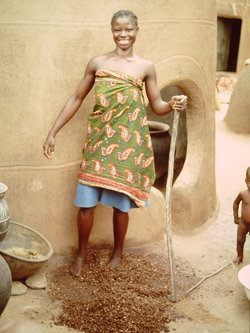 |
|
The seeds are pounded with the woman's feet
|
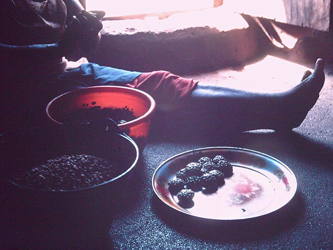 |
|
Forming spice-balls |
2. Those husks that have not dried completely on the tree will be dried on clean ground in the woman’s courtyard or on a flat roof.
3. The seeds are removed from the husks and separated from the yellow powder (da-buulim or da-zom) surrounding them. The sweet powder may be eaten immediately or mixed with water to make a kind of mush.
4. The seeds are washed and dried.
5. They are boiled in order to facilitate the removal of the thin skin covering them.
6. In order to remove these skins, the woman mixes the seeds with coarse sand in a big bowl (chari) and “pounds” them with her bare feet on clean ground. I’ve also heard that some women pound the kernels very carefully in a mortar so that only the skins are removed while the seeds remain unbroken.
7. The mixture is washed in a sieve-pot (ngoadi) to remove the sand.
8. The seeds are boiled again.
9. They are carefully pounded in a mortar into a coarse paste so that not all seeds are broken completely. Other women pound one half of the seeds into a fine paste and then mix them again with the unpounded ones. Again others will pound all the seeds into a fine paste.
10. Other spices or ingredients (e.g. soy beans) are rarely added.
11. The whole paste is kept in a containter to ferment for three days. The fermentation explains its pungent smell.
12. The woman forms small round or flat “cakes” (jongsa) of different sizes.
13. The balls are dried again.
14. Small quantities of the spice-balls may be stored in a yaling-basket fixed to a wall in the woman’s courtyard, or they are sold on the market.
15. Jongsa spices are used for nearly all soups but also for cooked leafy vegetables (e.g. tuita-bean leaves, Baobab leaves, etc.).
These days another form of dawa-dawa spice production has developed. The seeds are fried and then ground to a fine powder which can be drunk as "tea" or used as a spice for meals.
Shea Butter
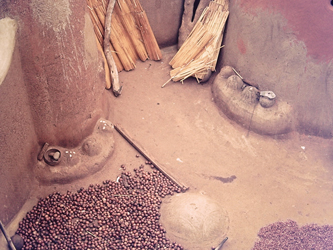 |
|
Shea nut are dried in an inner courtyard (4) |
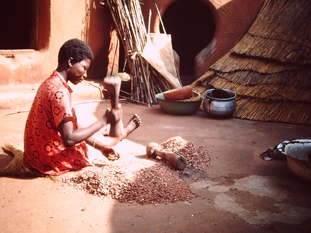 |
|
Removing the nut shells (5) |
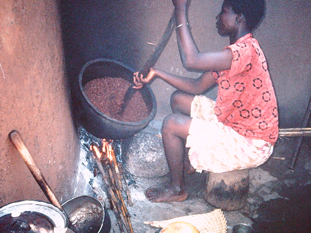 |
|
Roasting the kernels over a fire (7) |
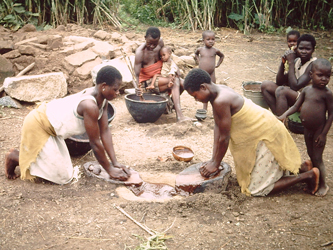 |
|
Grinding the dark paste (9) |
Before the importation of margarine and cooking oil, shea butter provided all of the dietary fats needed for cooking, and even today it is still the main source of grease for many traditional households.
To date, there are only a few shea plantations in North Ghana and none in Bulsaland. The fruit from these plantations (without pulp, but with shells) are mostly exported abroad, particularly for use in cosmetics.
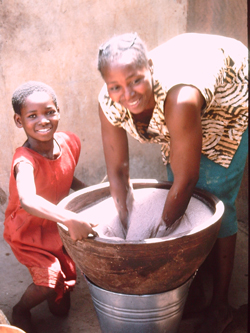 |
|
Beating the paste (10) |
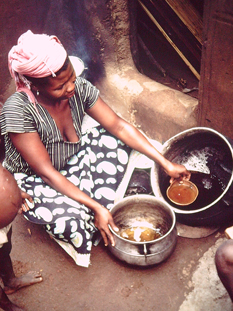 |
|
Ladling the liquid butter (11) |
Phases of production (Production methods seem to vary slightly from village to village. Furthermore, some modern methods, such as the use of grinding-machines, have intruded into the traditional way of production.):
1. At the end of the dry season, the woman gathers the wild-growing fruit of the shea nut trees in the bushland. She picks ripe as well as unripe fruit.
2. The green sweet pulps of ripe fruit are removed by hand, and they can be eaten by members of the family and animals. The hard, unripe fruit are either boiled or buried in the ground for some days until the pulp begins to rot.
3. The nuts are boiled in water.
4. They are dried until the interior is completely dry. The woman tests the state of the drying process by opening one nut.
5. Nuts which will not be stored are cracked either by means of a short pestle (buluk) or a stone, and the seeds are removed.
6. The seeds are dried again.
7. They are roasted in a pot over an open fire.
8. They are pounded to a coarse dark paste using a mortar and pestle.
9. In front of the compound, the dark paste is ground between two stones to become a fine dark paste which flows into a small hole dug in the ground.
10. This paste is kneaded and beaten in a big bowl, first by one hand and then by both hands until it becomes a whitish-yellow butter. During this process, cold and warm water are added so that the butter will float on the liquid.
11. The paste is cooked (usually in a metal pot these days) for about 2-3 hours until the sand (from the hole) falls onto the ground while the lighter grease can be ladled off.
10. The liquid butter is poured into small calabash bowls.
Millet-beer or Pito (daam)
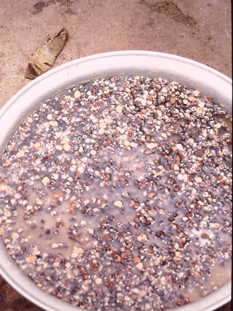 |
|
Soaking the red sorghum |
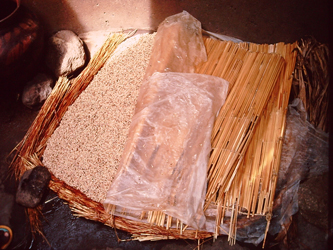 |
|
Germinating the sorghum |
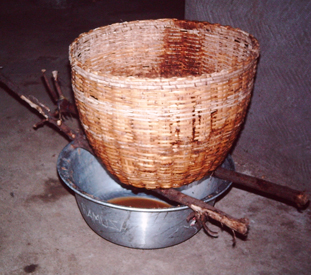 |
|
Filtering the mash |
In Northern Ghana millet beer can be bought and drunk in permanent pito-bars and at market stalls on market days. In addition, it is offered to shrines and distributed among the guests at large festivals and ritual events.
As the beer is boiled 2-3 times during preparation, it is also a safe drink for sensitive European stomachs. Some of the saleswomen in town add a bit of “tobacco” juice or, more precisely, cannabis juice, which is not very wholesome for some drinkers.
Although selling pito might be a lucrative source of additional income for the female brewers, they incur a loss if they cannot sell their whole production, since it only lasts for three days after production. In such a case, the brewer will offer the rest to relatives and neighbors without charge.
The preparation of millet beer, mostly from red guinea corn (sorghum) takes four days.
Phases of production:
1) The de-hulled millet seeds are soaked in a big dish (“head-pan”) with water.
2) They are spread on a clean area of the woman’s courtyard and covered with millet leaves, wet sacks or mats.
3) At least twice a day they are turned and sprinkled with water to make them germinate.
4) The germinated millet, also called malt (kpaam), will be boiled, ground and then mixed with water to form a mixture called mash (da-pusa). The amount of water affects the alcohol content of the beer.
5) The mash is boiled in a big cooking pot (samoaning), cooled off in a chandong (a big chari dish) and filtered through a sieve which is often an open basket. The residue (da-buta) in the sieve is later used as food for animals.
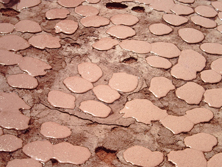 |
|
Producing yeast |
6) While the mash is boiled again, the woman continuously skims off the foam, which later is added again to the fermented beer to take away its sour taste.
7) The fermentation process is initiated in a big dish (chari). As a source of yeast, the residue of old millet, after having been dried in the form of round, flat cakes, is used. Yeast can, however, also be bought on the market. If an old pot in which pito has been kept is used for fermentation, yeast will not be necessary.
8) When the bubbling in the liquid has stopped, the fermentation has finished.
9) The beer is poured into a big ceramic vessel (liik or daam kabook) and transported to the place of consumption.
Soap
The production of soap, especially the old, traditional procedure, has nearly died out in Bulsaland because various imported brands of toilet soap and key soap can be bought in nearly any shop and at the market. During my field research in 1994, two different ways of production existed side by side: the old traditional way and a modernised one.
The old, traditional production of soap
In 1994 it was only Abiak’s wife in Wiaga who was able to produce soap according to the old method, though she had given up this job about 20 years before because of health problems and marketing difficulties. She was, however, ready to resume her old activity for documentation purposes of the researcher.
The only ingredients are “potash” (kaam) and shea nut butter. As the production of shea nut butter has been described above, I will confine myself to a description of “potash” and its use in soap production.
Several informants admit that soap produced in this way is inferior to imported key-soap, for it may dye cloths red, affect their texture and cause them to be torn easily.
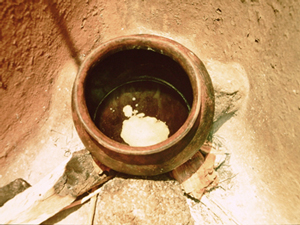 |
|
Katuak in the lower vessel (6) |
Phases of production:
1) To make kaam the woman needs black ashes from burnt millet stalks. Abiak’s wife bought these ashes at the market.
2) The ashes are poured into a particular ceramic pot (katuak cheng) which has a small hole covered with a potsherd in the middle of its bottom. In this construction it is used as a filter pot. The pot with ashes is placed on another container (kaam cheng), which in the observed case, is an aluminum pot.
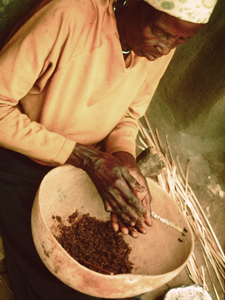 |
|
Abiak's wife forming soap-cakes |
3) The woman sprinkles 8 handfuls of cold water over the ashes.
4) Water is boiled over a stove and poured on the ashes.
5) Through the ashes and the small hole, the water drips into the lower vessel. It has absorbed substances from the ashes which give it a bitter taste. It is also called kaam.
6) The kaam-liquid is heated and completely evaporates, leaving only a small amount of white powder (katuak) on the bottom of the pot. This white powder is usually called potash, both in the ethnographic literature and by educated Bulsa.
7) The woman adds some shea nut butter to the white powder on the open fire. The stick for stirring this mixture must be taken from an okra plant and the stirring must take place only in one direction.
8) After 20 minutes the mixture has become soap and is placed in a shady place to cool down a little.
9) The still warm soap is shaped into small balls and is ready for use.
The modernized production of soap
The modern art of soap making does not have a long tradition among the Bulsa. It has been promoted and taught by a Catholic Women’s group called “Christian Mothers”.
Compared to the traditional way of making soap, the main difference consists of replacing potash with caustic soda. However, this can only be bought in the bigger towns of Northern Ghana.
I thank Rita Atuick (Wiaga Yisobsa) for allowing me to watch and document her work.
Phases of production
1) Shea nut butter and a smaller quantity of red palm oil are heated on a stove.
2) Rita cuts three onions into small pieces and puts adequate portions in the boiling shea nut butter and palm oil. The onions will cause any dirt to settle on the bottoms of the pots.
3) One kilogram of caustic soda is dissolved in a plastic bowl by adding four bottles of water. It is mixed with the corresponding quantities of shea nut butter and palm oil.
4) Rita prepares a wooden frame (inner measurement of 29 x 28 cm). In order to produce yellow and red soap, she divides it into two unequal parts using an additional wooden bar. Both sections are covered with plastic wrap.
5) Rita pours the shea nut butter into a bigger vessel, stirs it extensively for ten minutes (only in one direction!) and pours it into the larger compartment of the frame. The same is done with the smaller portion containing soda and the palm oil.
6) After 2½, respectively 3 hours, the shea nut butter and the palm oil soap have become hard. They are cut into suitable pieces with a sharp knife.
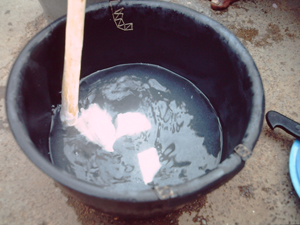 |
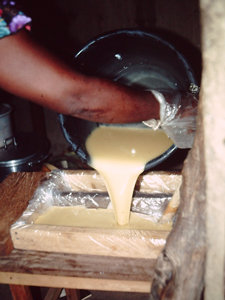 |
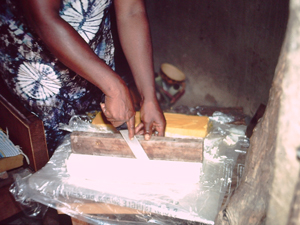 |
| Caustic soda and liquid
shea butter
are mixed (3) |
Pouring the soap into
the wooden frame (5) |
Cutting the hard soap into pieces (6) |
Pottery and Weaving
In addition to the activities described above, Bulsa women exercise several other crafts, the most important being pottery and basketry. Pottery, which is of considerable economic significance for some Bulsa households, is practised wherever suitable clay deposits exist.
Weaving mats, baskets, ropes, etc. can be done by men or women. Usually objects that are predominantly used by one of the two sexes are also produced only by members of the corresponding sex. For example, the busik basket, a typical container for storing and transporting things by women as well as thin waist-strings plaited from pak-grass, are made only by women while the sleeping mat (tiak) used by men, women and children can be woven (precisely “sewn”) by either sex.
As pottery and weaving have been described in detail elsewhere (Kröger 2001), we dispense with a detailed description here.
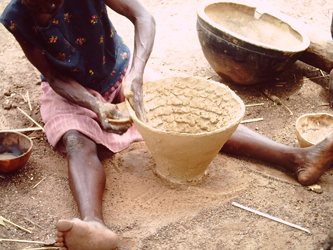 |
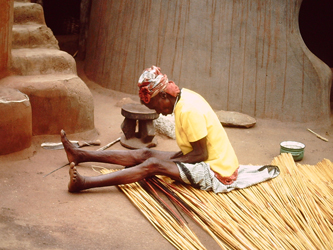 |
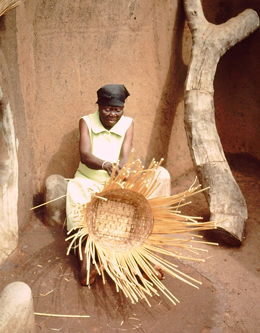 |
| Building up a pot with coils of clay | Weaving a sleeping mat (tiak) | Braiding a busik-basket |
Economic Aspects
Generally speaking, all crafts and other activities practised by a Bulsa woman may yield a considerable side income but, to my knowledge, may never cause her to give up her role as a housewife and mother to her children.
What does the woman use this extra cash for? Usually it does not go into the general household budget, for husband and wife earn and spend their own cash money. If a woman, for example, sells cigarettes, her husband has to pay separately for each cigarette he receives from her.
Of course, some women like to buy an additional piece of cloth which they will sew into a new dress. Others will save the money for the purchase of a sewing machine. If a woman would like to visit her own relatives in the south of Ghana, she has to cover at least part of the travelling expenses using her own cash. According to my observations, the largest percentage of her earned money goes towards purchases for her own children and typically include goods such as extra food, new clothes, bicycles, etc. There have been many cases in which a father, hesitant to send his children to school, finally agrees only after the mother was ready to pay for the school uniform and books.
Future Prospects
It is uncertain which crafts and other activities of Bulsa women will have a chance of survival
in the future.
The great importance of millet in the daily diet is going to be strongly influenced by the use of
wheat, which has the disadvantage of having to be imported from other countries. Its
advantage is that wheat flour can be baked into bread. Breakfast sandwiches with jam have
already partially displaced the morning kaponta-drink in modern households. Although TZ is
still the main hot dish, especially for dinner, the monotony of the menu is varied today by
different dishes of rice (plain rice, rice balls, Yollof rice, etc.) and yams, which have to be
imported from the southern yam belt and are sold in large Bulsa markets (e.g. Sandema and
Fumbisi). "Tin food" plays no major role in a traditional household, although a can of
mackerel may be bought as an ingredient for soup. TZ with a soup is the only hot meal that
can be sacrificed to shrines and is thus linked to the survival of the traditional religion.
Shea nut butter may be supplemented in richer households by imported oil (e.g. palm oil) or
margarine, although homemade butter is cheap to the point of almost being free since all
commodities (nuts, firewood, etc.) are collected in the bush.
Attempts to modernize shea nut butter production through investment in plantations, through
the mechanized production of large quantities and through exporting the finished butter have
had no success among the Bulsa, although some experimental projects among neighbouring
groups appear to have operated at a profit. One hindrance to the establishment of plantations
in the Bulsa area is the taboo on planting and transplanting young shea nut trees.
Millet beer (daam) will probably always remain a popular drink among the Bulsa. However, its rivals, bottled beer and strong drinks (e.g. gin, schnapps and akpeteshi, a palm-brandy) have some advantages to consumers: they are durable for a long time and the physical effects of the alcohol appear more rapidly. Movements against the abuse of these drinks are in full swing. The Sandemnaab wants to enforce a law against the sale of these beverages in private households. Some groups want to ban the consumption of strong drinks at funeral celebrations throughout the area, and a few Protestant churches (e.g. the Restoration Chapel in Wiaga) reject the consumption of all alcoholic beverages.
For sacrifices at shrines, only millet beer may be used as an alcoholic libation, although it is common to pour a few drops from a bottle of a strong drink on the ground in order to give the ancestors their share before the first living person starts drinking.
Of all the activities described here, the two methods of soap making probably have the lowest
chances of survival in the coming years. Although the older traditional method does not incur
any financial expenses, the amount of work is still tremendous and the output is relatively
low. The modern production with caustic soda as an ingredient is expected to experience a
strong decline or even completely disappear if a soap factory is ever founded in northern
Ghana or even in the Bulsa District itself.
Pottery and basketry and their products have better prospects of survival, although currently
ceramic vessels are largely being replaced by imports from East Asia (e.g. aluminum pots,
enamel bowls and plastic plates). In the last decades, aluminum vessels which have been sand-cast in Sandema Choabisa since the 1990s have, to a certain degree, replaced some ceramic
cooking pots.
However, clay vessels are likely to hold their own in two fields. In ritual life they may even be part of a shrine since, as knobbed vessels filled with earth, they represent ma-bage ancestral shrines. They also play a role in sacrifices. For collecting the blood of a slaughtered animal, for transporting sacrificial millet beer or for storing traditional medicines, no metal or plastic vessel may be used.
Possibly an expansion of ceramic technologies and products may take place in the area of
artistic crafts. The kick-off for this could be a burgeoning tourism. New forms and functions
may arise and could include such items as flower vases, flower pots for the verandahs of
modern Bulsa houses or even a figural art.
Woven straw baskets such as the previously mentioned busik are designed as ideal containers
for transporting loads on one’s head. If this mode of transport, however, should be abandoned,
several basket types would become useless. Even with the attachment of handles, most
existing forms would not be well suited.
The sleeping mat (tiak), however, has a good chance of survival, although more and more
Bulsa prefer to sleep in a bed. In funeral rites in which this mat symbolically represents the
deceased, it will certainly play a major role for a long time to come.
The restriction in practising crafts and other traditional activities depends to a great extent on
the economic development of Ghana. Since the late 1980s, the region has experienced
economic prosperity, and the Bulsa market has been flooded with imported goods which have
caused a decline in traditional crafts. Economic crises, however, cannot only lead to an
intensification of existing traditional technologies but to a resurgence of long discontinued
production methods, and thus outdated objects may be reused again. At the height of the
economic crisis in the early 1980s when it was barely possible to purchase fuel for kerosene
lamps, potters started manufacturing and selling earthen lamps which were filled with shea nut
oil while an old rag or some kapok-wool served as a wick.
We cannot foresee future developments. It is, however, quite likely that for a long time the
products of old technologies will be used alongside imported goods in traditional and modern
Bulsa households.
Literature
Apentiik, Rowland (1997): Bulsa Technologies and Systems of Thought. MA-thesis. University of Calagary, Department of Archaeology. Calgary (Alberta, Canada), unpublished.
Bawa (now Arnheim), Margaret Lariba (1979): The Brewing (Cooking) of daam (millet beer) - Daam dika. Münster, unpublished paper in English and Buli, 7 pp.
Bawa (now Arnheim), Margaret Lariba (1979): The Preparation of saab (millet-porridge) - Saab manika. Münster, unpublished paper in English and Buli, 18 pp.
Doering, v. (1904): Über die Herstellung von Seife in Togo. Globus, pp. 282-283.
Ghana Home Page (19 September 2015): Shea Butter Earning Doubles. 2pp.
Heermann, Ingrid (1981): Subsistenzwirtschaft und Marktwirtschaft im Wandel. Wirtschaftsethnologische Forschungen bei den Bulsa in Nordghana. Hohenschäftlarn bei München: Klaus Renner.
Klose, H. (1904): Industrie und Gewerbe in Togo. Globus, 85, Nr. 5, p. 69-73, no. 6, p. 89-93.
Kröger, Franz
1992 Buli-English Dictionary. Münster and Hamburg: Lit-Verlag.
2001 Materielle Kultur und traditionelles Handwerk bei den Bulsa (Nordghana), 2 vol., Münster, Hamburg and London: Lit-Verlag.
Meier, Barbara (1999): Doglientiri: an Institutionalised Relationship between Women among the Bulsa of Northern Ghana. Africa (London), 69,1, S. 87-107.
Saul, Mahir (1981): Beer, Sorghum and Women. Production for the Market in Rural Upper Volta. In: Africa 51/3:746-64.
Schott, Rüdiger (1970): Aus Leben und Dichtung eines westafrikanischen Bauernvolkes. Ergebnisse völkerkundlicher Forschungen bei den Bulsa in Nord-Ghana 1966/67, Arbeitsgemeinschaft für Forschung des Landes Nordrhein-Westfalen, Geisteswissenschaften, Heft 163, Köln und Opladen.
Striewisch, Martin (1988): Die Bedeutung des Hirsebierbrauens für die wirtschaftliche und soziale Stellung der Frau in westafrikanischen Gesellschaften. Unpublished paper (M.A.) Münster (pp. 168-179: Bulsa).